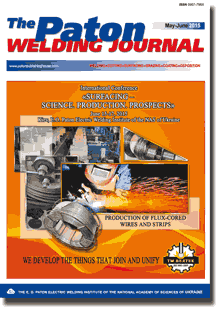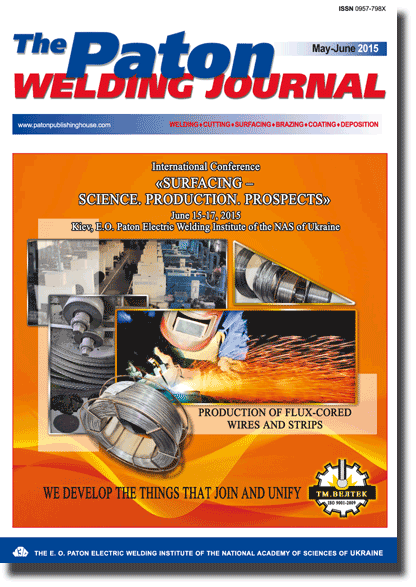Access for download PDF files for subscribers and for reviewers of scientometric bases.
Organization: Elsevier for content access(PDF files of journals released before 2024 are available for download from the website's archives))
Organization: Elsevier for content access(PDF files of journals released before 2024 are available for download from the website's archives))
| 2015 №06 (28) |
DOI of Article 10.15407/tpwj2015.06.29 |
2015 №06 (30) |

The Paton Welding Journal, 2015, #5-6, 130-133 pages
Structural scheme of procedure for calculation of stress-strain state of parts during surfacing and further service
I.K. Senchenkov1, I.A. Ryabtsev2 And E. Turyk3
1S.P. Timoshenko Institute of Mechanics, NASU. 3 Nesterov Str., 03057, Kiev, Ukraine. E-mail: ang@inmex.kiev.ua
2E.O. Paton Electric Welding Institute, NASU. 11 Bozhenko Str., 03680, Kiev, Ukraine. E-mail: office@paton.kiev.ua
3Welding Institute. 16-18 B. Czeslaw Str., 44100, Gliwice, Poland. E-mail: eugeniusz.turyk@glivice.pl
Abstract
Structural scheme of calculation procedure for estimation of stress-strain and microstructural state of parts during surfacing process and further operation is presented. The procedure is based on the following mathematical models: initial condition, including stress-strain and structural state in process of production surfacing; evolution of service and structural parameters in process of operation; accumulation of damageability and reduction of fatigue life; reconstruction surfacing. In comparison with experimental methods, mathematical modelling allows evaluating stress-strain and structural state of the parts in process of surfacing and further operation with lower expenses and more efficient. 20 Ref., 3 Figures.
Keywords: surfacing, stress-strain state, microstructural state, mathematical modelling, calculation procedure
Received: 20.04.15
Published: 28.07.15
References
1. Krempl, E. (2000) Viscoplastic models for high temperature applications. Int. J. Solids and Structures, 37, 279-291. https://doi.org/10.1016/S0020-7683(99)00093-1
2. Nix, W.D., Gibeling, J.C., Hughes, D.A. (1985) Time-dependent behavior of metals. Met. Transact. A, 16, 2216-2226.
3. Makhnenko, V.I. (2006) Safety life of welded joints and assemblies in modern structures. Kiev: Naukova Dumka.
4. Senchenkov, I.K., Turyk, E., Ryabtsev, I.A. et al. (2003) Modeling of nonisothermic growing of physically nonlinear bodies and technological appendices. Teor. i Prikl. Mekhanika, Issue 38, 109-114.
5. Senchenkov, I.K., Tabieva, G.A., Ryabtsev, I.A. et al. (2004) Numerical modeling of residual stresses and strains in multilayer surfacing of cylindrical parts. In: Proc. of 2nd Int. Conf. on Mathematical Modelling and Information Technologies in Welding and Related Processes (13-17 Sept. 2004, Katsiveli, Ukraine), 237-242. Kiev: PWI.
6. Senchenkov, I.K. (2005) Thermomechanical model of growing cylindrical bodies from physically nonlinear materials. Prikl. Mekhanika, 41(9), 118-126.
7. Senchenkov, I.K., Chervinko, O.P., Turyk, E. et al. (2007) Investigation of thermomechanical state of cylindrical parts deposited by austenitic and martensitic steel layers. Svarochn. Proizvodstvo, 8, 6-13.
8. Popov, A.A., Popova, L.E. (1961) Handbook of heat-treater. Isothermal and thermokinetic diagrams of overcooled austenite decomposition. Moscow-Sverdlovsk: GNTI Mashinostr. Lit.
9. Leblond, J.B., Mottet, G., Devaux, J.C. (1986) A theoretical and numerical approach to the plastic behavior of steel during phase transformation. Pt 1: Derivation of general relations. J. Mech. Phys. Solids, 34(4), 395-409. https://doi.org/10.1016/0022-5096(86)90009-8
10. Bodner, S.R. (1984) Evolution equations for anisotropic hardening and damage of elastic-viscoplastic materials. Plasticity today: Modelling methods and applications. In: Elsevier Applied Sci., 471-482.
11. Bodner, S.R. (2000) Unified plasticity - An engineering approach (Final report). Haifa: Isr.IT.
12. Bodner, S.R. (2005) Plasticity over a wide range of strain rates and temperatures. Archives of Mechanics, 57(2/3), 73-80.
13. Senchenkov, I.K., Tabieva, G.F. (1996) Determination of parameters of Bodner-Partom model of thermoviscoplastic deformation of materials. Prikl. Mekhanika, 32(2), 64-72. https://doi.org/10.1007/bf02086653
14. Shorshorov, M.Kh., Belov, V.V. (1972) Phase transformations and changes of properties during welding: Atlas. Moscow: Nauka.
15. Henwood, C., Bibby, M., Goldak, J. et al. (1988) Coupled transient heat transfer - microstructure weld computations (Pt B). Acta Metall., 36(11), 3037-3046. https://doi.org/10.1016/0001-6160(88)90186-1
16. Makhnenko, V.I., Velikoivanenko, E.A., Kravtsov, T.G. et al. (2001) Numerical studies of thermomechanical processes in surfacing of shafts of ship mechanisms. The Paton Welding J., 1, 2-10.
17. Sheng, I.C., Chen, Y. (1992) Modelling welding by surface heating. J. Eng. Materials and Techn., 114, 439-449. https://doi.org/10.1115/1.2904197
18. Ueda, Y., Murakawa, H., Luo, Y.A. (1995) Computational model of phase transformation for welding processes. Transact. of JWRI, 24(1), 95-100.
19. Kachanov, L.M. (1958) On the time of failure under creep conditions. Izvestiya AN SSSR, 8, 26-31.
20. Krajeinovic, D. (1996) Damage mechanics. Amsterdam: Elsevier.
Suggested Citation
I.K. Senchenkov, I.A. Ryabtsev And E. Turyk (2015) Structural scheme of procedure for calculation of stress-strain state of parts during surfacing and further service. The Paton Welding J., 06, 130-133.The cost of subscription/purchase order journals or individual articles
| Journal/Currency | Annual Set | 1 issue printed |
1 issue |
one article |
| TPWJ/USD | 384 $ | 32 $ | 26 $ | 13 $ |
| TPWJ/EUR | 348 € | 29 € | 24 € | 12 € |
| TPWJ/UAH | 7200 UAH | 600 UAH | 600 UAH | 280 UAH |
| AS/UAH | 1800 UAH | 300 UAH | 300 UAH | 150 UAH |
| AS/USD | 192 $ | 32 $ | 26 $ | 13 $ |
| AS/EUR | 180 € | 30 € | 25 € | 12 € |
| SEM/UAH | 1200 UAH | 300 UAH | 300 UAH | 150 UAH |
| SEM/USD | 128 $ | 32 $ | 26 $ | 13 $ |
| SEM/EUR | 120 € | 30 € | 25 € | 12 € |
| TDNK/UAH | 1200 UAH | 300 UAH | 300 UAH | 150 UAH |
| TDNK/USD | 128 $ | 32 $ | 26 $ | 13 $ |
| TDNK/EUR | 120 € | 30 € | 25 € | 15 € |
AS = «Automatic Welding» - 6 issues per year;
TPWJ = «PATON WELDING JOURNAL» - 12 issues per year;
SEM = «Electrometallurgy Today» - 4 issues per year;
TDNK = «Technical Diagnostics and Non-Destructive Testing» - 4 issues per year.


